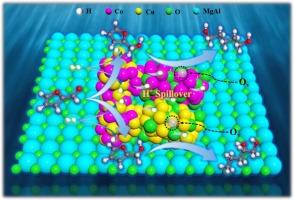Oxygen vacancy-rich metal oxides and Co-Cu alloy bifunctional sites for selective conversion of furfural to 1,2-pentanediol and 1,5-pentanediol
IF 6.5
1区 化学
Q2 CHEMISTRY, PHYSICAL
引用次数: 0
Abstract
One-step conversion of biomass-derived furfural (FA) to 1,2-pentanediol (1,2-PeD) and 1,5-pentanediol (1,5-PeD) by selective cleavage of C![]() O
O![]() C is of great significance. However, the lack of knowledge of the active sites in this reaction leads to poor catalytic performance over the currently used non-noble metal hydrogenation catalysts. In this work, xCoyCu/MgAlOx-T catalysts with Co-Cu alloy as well as Ov-rich CuO and CoO bifunctional active sites were constructed by modulating the metal ratio and reduction temperature. During the reaction, the Co-Cu alloy enhanced the H2 dissociation efficiency and hydrogenation of FA to furfuryl alcohol (FOL). In addition, the C
C is of great significance. However, the lack of knowledge of the active sites in this reaction leads to poor catalytic performance over the currently used non-noble metal hydrogenation catalysts. In this work, xCoyCu/MgAlOx-T catalysts with Co-Cu alloy as well as Ov-rich CuO and CoO bifunctional active sites were constructed by modulating the metal ratio and reduction temperature. During the reaction, the Co-Cu alloy enhanced the H2 dissociation efficiency and hydrogenation of FA to furfuryl alcohol (FOL). In addition, the C![]() O
O![]() C is inclined to adsorb on the Ov-rich CuO and CoO, while the active H* dissociates from the Co-Cu alloy and spills out onto the surfaces of CuO and CoO to participate in the hydrogenation reaction. Moreover, DFT calculation shows that Ov-rich CuO and CoO significantly reduce the cleavage energy barrier of C
C is inclined to adsorb on the Ov-rich CuO and CoO, while the active H* dissociates from the Co-Cu alloy and spills out onto the surfaces of CuO and CoO to participate in the hydrogenation reaction. Moreover, DFT calculation shows that Ov-rich CuO and CoO significantly reduce the cleavage energy barrier of C![]() O
O![]() C bond, leading to 22.57 % yield of 1,2-PeD and 49.78 % yield of 1,5-PeD over 3Co1Cu/MgAlOx-600. This study provides an in-depth understanding of the reaction mechanism of FA conversion to 1,2-PeD and 1,5-PeD, as well as offers a viable approach for the construction of bifunctional catalysts.
C bond, leading to 22.57 % yield of 1,2-PeD and 49.78 % yield of 1,5-PeD over 3Co1Cu/MgAlOx-600. This study provides an in-depth understanding of the reaction mechanism of FA conversion to 1,2-PeD and 1,5-PeD, as well as offers a viable approach for the construction of bifunctional catalysts.


富氧空的金属氧化物和Co-Cu合金的双功能位点选择性转化糠醛为1,2-戊二醇和1,5-戊二醇
生物质衍生的糠醛(FA)通过选择性裂解COC一步转化为1,2-戊二醇(1,2- ped)和1,5-戊二醇(1,5- ped)具有重要意义。然而,由于缺乏对该反应活性位点的了解,导致目前使用的非贵金属加氢催化剂的催化性能较差。通过调节金属比和还原温度,构建了具有Co-Cu合金和富含ov的CuO和CoO双功能活性位的xCoyCu/MgAlOx-T催化剂。在反应过程中,Co-Cu合金提高了氢解离效率和FA加氢制糠醇(FOL)。COC倾向于吸附在富含ov的CuO和CoO上,而活性H*则从Co-Cu合金中游离出来,溢出到CuO和CoO表面,参与加氢反应。此外,DFT计算表明,富含ov的CuO和CoO显著降低了COC键的解理能垒,导致3Co1Cu/MgAlOx-600的1,2- ped产率为22.57 %,1,5- ped产率为49.78 %。本研究深入了解了FA转化为1,2- ped和1,5- ped的反应机理,并为构建双功能催化剂提供了可行的途径。
本文章由计算机程序翻译,如有差异,请以英文原文为准。
求助全文
约1分钟内获得全文
求助全文
来源期刊

Journal of Catalysis
工程技术-工程:化工
CiteScore
12.30
自引率
5.50%
发文量
447
审稿时长
31 days
期刊介绍:
The Journal of Catalysis publishes scholarly articles on both heterogeneous and homogeneous catalysis, covering a wide range of chemical transformations. These include various types of catalysis, such as those mediated by photons, plasmons, and electrons. The focus of the studies is to understand the relationship between catalytic function and the underlying chemical properties of surfaces and metal complexes.
The articles in the journal offer innovative concepts and explore the synthesis and kinetics of inorganic solids and homogeneous complexes. Furthermore, they discuss spectroscopic techniques for characterizing catalysts, investigate the interaction of probes and reacting species with catalysts, and employ theoretical methods.
The research presented in the journal should have direct relevance to the field of catalytic processes, addressing either fundamental aspects or applications of catalysis.
 求助内容:
求助内容: 应助结果提醒方式:
应助结果提醒方式:


